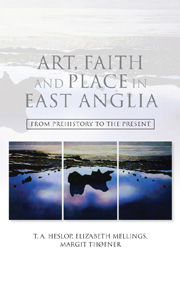Book contents
- Frontmatter
- Contents
- Acknowledgements
- List of illustrations
- CHAPTER 1 ‘Introduction: On Faith, Objects and Locality’
- CHAPTER 2 ‘But where is Norfolk?’
- CHAPTER 3 ‘Sacred Image and Regional Identity in Late-Prehistoric Norfolk’
- CHAPTER 4 ‘Piety from the Ploughsoil: Religion in Roman Norfolk through Recent Metal-Detector Finds’
- CHAPTER 5 ‘Paganism in Early-Anglo-Saxon East Anglia’
- CHAPTER 6 ‘Devotion, Pestilence and Conflict: The Medieval Wall Paintings of St Mary the Virgin, Lakenheath’
- CHAPTER 7 ‘Here Be Dragons: The Cult of St Margaret of Antioch and Strategies for Survival’
- CHAPTER 8 ‘The Medieval Jews of Norwich and their Legacy’
- CHAPTER 9 ‘Late-Medieval Glass-Painting in Norfolk: Developments in Iconography and Craft c.1250–1540’
- CHAPTER 10 ‘Graffiti and Devotion in Three Maritime Churches’
- CHAPTER 11 ‘Norfolk Wayside Crosses: Biographies of Landscape and Place’
- CHAPTER 12 ‘Landscapes of Faith and Politics in Early-Modern Norwich’
- CHAPTER 13 ‘Practice and Belief: Manifestations of Witchcraft, Magic and Paganism in East Anglia from the Seventeenth Century to the Present Day’
- CHAPTER 14 ‘Provinciality and the Victorians: Church Design in Nineteenth-Century East Anglia’
- CHAPTER 15 ‘Maharajah Duleep Singh, Elveden and Sikh Pilgrimage’
- CHAPTER 16 ‘Supernatural Folklore and the Popular Imagination: Re-reading Object and Locality in Mid-Nineteenth-Century Norfolk’
- CHAPTER 17 ‘Pro Patria Mori: Christian Rallies and War Memorials of Early-Twentieth-Century Norfolk’
- CHAPTER 18 ‘Pagans in Place, from Stonehenge to Seahenge: “Sacred” Archaeological Monuments and Artefacts in Britain’
- CHAPTER 19 ‘Art, Spirit and Ancient Places in Norfolk’
- CHAPTER 20 ‘Sacred Sites and Blessed Objects: Art and Religion in Contemporary Norfolk’
- Bibliography
- Index
CHAPTER 1 - ‘Introduction: On Faith, Objects and Locality’
Published online by Cambridge University Press: 05 April 2013
- Frontmatter
- Contents
- Acknowledgements
- List of illustrations
- CHAPTER 1 ‘Introduction: On Faith, Objects and Locality’
- CHAPTER 2 ‘But where is Norfolk?’
- CHAPTER 3 ‘Sacred Image and Regional Identity in Late-Prehistoric Norfolk’
- CHAPTER 4 ‘Piety from the Ploughsoil: Religion in Roman Norfolk through Recent Metal-Detector Finds’
- CHAPTER 5 ‘Paganism in Early-Anglo-Saxon East Anglia’
- CHAPTER 6 ‘Devotion, Pestilence and Conflict: The Medieval Wall Paintings of St Mary the Virgin, Lakenheath’
- CHAPTER 7 ‘Here Be Dragons: The Cult of St Margaret of Antioch and Strategies for Survival’
- CHAPTER 8 ‘The Medieval Jews of Norwich and their Legacy’
- CHAPTER 9 ‘Late-Medieval Glass-Painting in Norfolk: Developments in Iconography and Craft c.1250–1540’
- CHAPTER 10 ‘Graffiti and Devotion in Three Maritime Churches’
- CHAPTER 11 ‘Norfolk Wayside Crosses: Biographies of Landscape and Place’
- CHAPTER 12 ‘Landscapes of Faith and Politics in Early-Modern Norwich’
- CHAPTER 13 ‘Practice and Belief: Manifestations of Witchcraft, Magic and Paganism in East Anglia from the Seventeenth Century to the Present Day’
- CHAPTER 14 ‘Provinciality and the Victorians: Church Design in Nineteenth-Century East Anglia’
- CHAPTER 15 ‘Maharajah Duleep Singh, Elveden and Sikh Pilgrimage’
- CHAPTER 16 ‘Supernatural Folklore and the Popular Imagination: Re-reading Object and Locality in Mid-Nineteenth-Century Norfolk’
- CHAPTER 17 ‘Pro Patria Mori: Christian Rallies and War Memorials of Early-Twentieth-Century Norfolk’
- CHAPTER 18 ‘Pagans in Place, from Stonehenge to Seahenge: “Sacred” Archaeological Monuments and Artefacts in Britain’
- CHAPTER 19 ‘Art, Spirit and Ancient Places in Norfolk’
- CHAPTER 20 ‘Sacred Sites and Blessed Objects: Art and Religion in Contemporary Norfolk’
- Bibliography
- Index
Summary
East Anglia is a distinct region and has been considered so for over a millennium. This is how one tenth-century writer, Abbo of Fleury, saw it:
The above-mentioned eastern part attracts attention for the following and other reasons: that it is washed by waters on almost every side, girdled as it is on the south and east by the ocean, and on the north by an immense tract of marsh and fen … But on the side where the sun sets, the province is in contact with the rest of the island, and on that account accessible; but as a bar to constant invasion by an enemy, a foss is sunk in the earth by a mound equivalent to a wall of considerable height.
For Abbo, East Anglia was a peninsula, separate from yet also joined to the rest of England. Much later, in the 1980s, the author Malcolm Bradbury would unwittingly reiterate this when he quipped that East Anglia was cut off by the North Sea on three sides and British Rail on the fourth. Evidently, the region may be defined clearly and conveniently by its landscape, understood as a conjunction of the natural and the manmade.
For quite some time now, archaeologists, geographers, historians, art historians and other scholars have understood that landscapes are simultaneously geographical and cultural. That is certainly a sensible way of seeing the East Anglian landscape, where fishing, farming, peat digging, reed harvesting, land drainage, wharf building and a multitude of other human activities have been undertaken across many centuries.
- Type
- Chapter
- Information
- Art, Faith and Place in East AngliaFrom Prehistory to the Present, pp. 1 - 18Publisher: Boydell & BrewerPrint publication year: 2012



